Fleas are blood-sucking parasites, which can live next to a person, in his home, for years, and be a carrier of a number of serious diseases. The bites of these insects are accompanied by unpleasant pain, itching and redness.
You can distinguish them by their bites from other blood-sucking parasites (bedbugs, lice, mosquitoes) using photographs that clearly demonstrate the marks left on the skin.
Record content:
- 1 Causes
- 2 Transmissible diseases
- 3 Diagnostics
- 4 When to see a doctor
- 5 Prophylaxis
-
6 Treatment methods
- 6.1 Medications
- 6.2 Traditional methods
- 6.3 Other methods
- 7 Possible complications
- 8 Flea Bite Video
Causes
Fleas can attack a person if there is no other food source (animal or bird) nearby. However, there are also such species of insects that parasitize only on humans.
Flea bites are caused by their sudden appearance in a person's home (regardless of sanitary conditions).
Fleas can appear spontaneously:
- from pets;
- get into the apartment from the street with dirty shoes;
- move from neighboring apartments, basement, attic, non-residential or technical premises through open windows, balconies, doors;
- be brought into the house after walking pets or when mice and rats appear in the house.
Any species of fleas living on warm-blooded animals and birds can attack a person:
- dog, cat, chicken, rat fleas - parasitize on different types of animals;
- human fleas - appear in the house, hiding in the scalp of the skin;
- earthen fleas - they breed in the upper layers of the soil, in the house they are localized mainly on furniture, behind skirting boards or wallpaper, in carpets;
- bedding - they live in bedding and upholstery, they bite mainly at night;
- sandy - live in sandy soils of coniferous forests, differ not only in that they bite through the skin, but also penetrate the skin of the victim.
Insects live and breed in the wool or feathers of animals that are ideal for their habitat, or in fleecy surfaces and fabrics (blankets, rugs, bedspreads), as well as in the crevices of the walls and other secluded places in home. And although they bite a person, they do not live on his body.
Transmissible diseases
A flea bite on a person, whose photo clearly shows the visible consequences of an insect attack, is dangerous not only for its external signs and discomfort.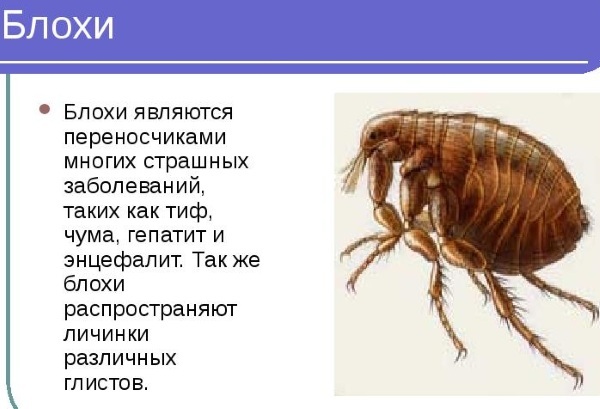
Fleas are carriers of various diseases, including those that are fatal to humans. So, rat fleas are considered one of the reasons for the spread of plague epidemics, which destroyed medieval settlements and entire cities.
| Types of diseases | Classification | Incubation period, days | Carriers of the pathogen | Brief description, symptoms |
| Diseases of the musculoskeletal system | Brucellosis | 7 – 14 | Cattle, small ruminants, pigs. | It is characterized by joint pain, weakness, sweating, and an abrupt increase in body temperature. Over time, the disease spreads to other organs, including the nervous, respiratory, cardiovascular, digestive and genitourinary systems. |
| Diseases of the nervous and cardiovascular systems | Typhus | 6 – 14 | Small rodents. | Severe headaches, disorientation, pink rash, fever, chills, back pain, high fever. Death is possible. |
| Encephalitis | 4 – 21 | Livestock, small rodents, birds. | The virus infects nerve cells and spreads to the brain. May be accompanied by nausea, vomiting, headaches, fever, seizures, impaired consciousness, loss of sensation of the limbs, hallucinations. | |
| Listeriosis | 7 – 30 | Pets. | Weakness, fever, inflammation of the lymph nodes, headaches, conjunctivitis, tonsillitis, rash. The disease can take the form of encephalitis, meningitis. Death is possible. | |
| Skin diseases | anthrax | 2 – 4 | Livestock. | The formation of a carbuncle (most often single), followed by ulceration and the appearance of a scab, accompanied by an increase in body temperature, fever, weakness, itching and swelling. With an intestinal or pulmonary form, a lethal outcome is possible. |
| Tularemia | From a few hours to 21 days | Small rodents, hares, rabbits. | The infection affects the skin, lymph nodes, sometimes affecting the mucous membranes. It is accompanied by headaches, fever, muscle aches, swollen lymph nodes, sweating, and pinpoint lesions of the mucous membranes. | |
| Bubonic plague | 2 – 12 | Small rodents, wild and domestic animals. | It is characterized by the presence of a specific bubo (pronounced skin neoplasm, most often in the groin), fever, high temperature, pain in the groin region, weakness. | |
| Diseases of the digestive tract | Pseudotuberculosis | 3 – 21 | Small rodents. | It affects the intestines, spreading to the liver, sometimes affecting the joints. The disease is characterized by fever, fever, abdominal pain, diarrhea, vomiting, headaches, conjunctivitis, white plaque on the tongue. |
| Salmonellosis | From 6 h. up to 2 days | Wild and domestic animals, man. | Acute intestinal infection, accompanied by symptoms: vomiting, weakness, diarrhea, abdominal pain, fever, dehydration. |

Any infectious disease transmitted by blood-sucking parasites is called vector-borne. Infection can enter the human body not only with the saliva of an insect, but also when combing an existing wound from a bite.
However, flea bites can not only lead to infection by a virus or bacterium, but also cause the body to respond to saliva containing substances that prevent the victim's blood from clotting.
They can cause an allergic reaction and contribute to the development of dermatitis, eczema, urticaria, Quincke's edema. Children and persons prone to allergies are especially susceptible to this phenomenon.
Diagnostics
A flea bite is not a disease, and insects themselves do not always act as carriers of an infection that is dangerous to humans. However, the attacks of these parasites should be distinguished from other blood-sucking insects (the methods of prevention and treatment), guided by visual photographs and existing symptoms that deliver the discomfort.
They are characterized by:
- the appearance of red itchy swelling on the body;
- spots are located chaotically, but close to each other;
- when scratching, spots and blisters can turn into wounds, and persist on the body for up to 2 days;
- if an allergic reaction occurs, bite marks can remain much longer;
- the main places on the human body that are attacked by insects are the lower limbs;
- fleas bite closed areas of the body, so bites should be looked for under clothing;
- an exception to the rule are fleas that live in a person's dwelling - they prefer to attack at night, and bites can be found on the body everywhere, including on the face;
- when bitten, a person feels pain, since insect saliva does not contain anesthetic components.
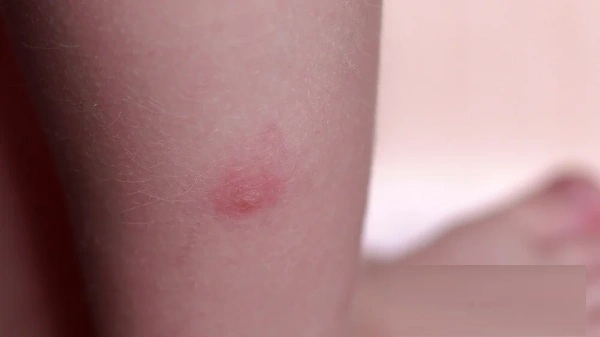
Diagnosis of possible diseases that can cause flea bites will depend on the initial information received about existing complaints and the results of general tests. The effectiveness of a particular method may differ in each case.
Diagnostics includes:
- Collecting anamnesis - obtaining information about existing complaints, previously identified chronic diseases and the patient's lifestyle based on his survey.
- Laboratory diagnostic methods:
- general and biochemical blood test;
- general urine analysis;
- serological blood tests.
- Instrumental diagnostic methods are informative in case of diseases accompanied by inflammatory processes in the lymph nodes, digestive tract organs, respiratory and cardiovascular systems:
- X-ray (from 120 rubles);
- Ultrasound of lymph nodes, respiratory and gastrointestinal tract (from 1000 rubles);
- CT and MRI of the abdominal cavity (from 900 rubles);
- gastroscopy (from 1000 rubles);
- enteroscopy (from 900 rubles);
- endoscopy (from 1900 rubles).
You can undergo an initial examination and pass general tests free of charge at a state medical institution at the place of registration under the compulsory medical insurance policy. You should apply for further examination at any diagnostic center or clinic in Moscow, depending on the location and price preferences.
When to see a doctor
A flea bite on a person, a photo of which demonstrates possible variations of it manifestations, may serve as a reason for contacting a medical institution in the presence of the following symptoms:
- long-lasting spots and regular itching;
- an increase in the area of irritation and the development of spots into ulcers;
- the appearance of pus on the wounds;
- the occurrence of ulceration on the mucous membranes of the oral cavity;
- the appearance of weakness in the body, dizziness;
- fever, chills, and fever;
- severe swelling at the site of the bite;
- the occurrence of attacks of suffocation, a feeling of congestion in the larynx;
- inflammation of the lymph nodes.
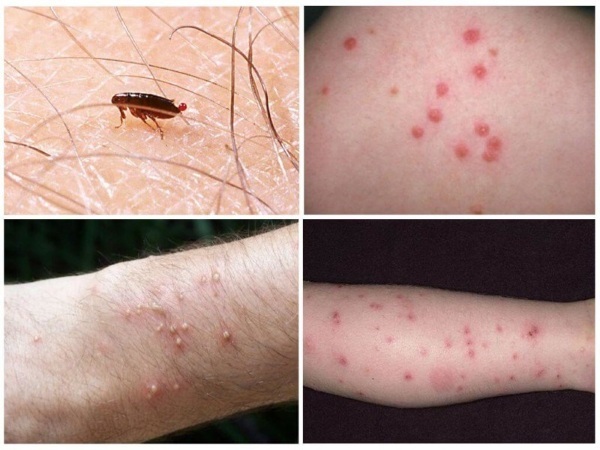
The primary examination is carried out by a therapist, who, based on the results of the examination, will prescribe diagnostic measures and if necessary, give a referral to another doctor: dermatologist, otorhinolaryngologist, surgeon, gastroenterologist, neuropathologist.
Prophylaxis
Preventive measures against flea bites are aimed at preventing the appearance of insects in human dwellings, and include:
- regular cleaning indoors, including in hard-to-reach places;
- if insects have already appeared in the house, you should carefully close up the existing cracks (in windows, walls, under the baseboards), and lay out the dried plants that repel fleas (tansy, mint, wormwood);
- carefully check the hair of pets for the presence of parasites;
- purchase special flea collars and other means of protection against parasites for animals;
- carry out timely cleaning of bedding and rugs for animals;
- wash paws of animals after walking outside;
- once a month, carry out general cleaning with a soda-soap solution, which repels insects.
If trouble still could not be avoided, you should call the sanitary-epidemiological service or other disinsection service to professionally eliminate the problem.
Treatment methods
A flea bite on a person (a photo and description of which is usually enough to recognize it) most often does not require any specific treatment, and the main methods of therapy are reduced to self-elimination of unpleasant consequences after him.
Medications
For flea bites, you should use products that relieve itching and disinfect damaged skin.
Usually they are available in the form of ointments, gels, solutions for external use:
- Sulfuric ointment - an antipruritic drug with antiseptic properties. It can be applied to the affected areas up to 3 times a day, but not more than 5 days. It is unacceptable for children under 3 years of age. Cost - from 20 to 50 rubles.
-
Fenistil gel - a remedy for the bites of various insects and allergic reactions that occur, which can be used by children (over 1 month old). The ointment is applied 2 to 4 times a day, until the symptoms are eliminated. Price 400 - 800 rubles.
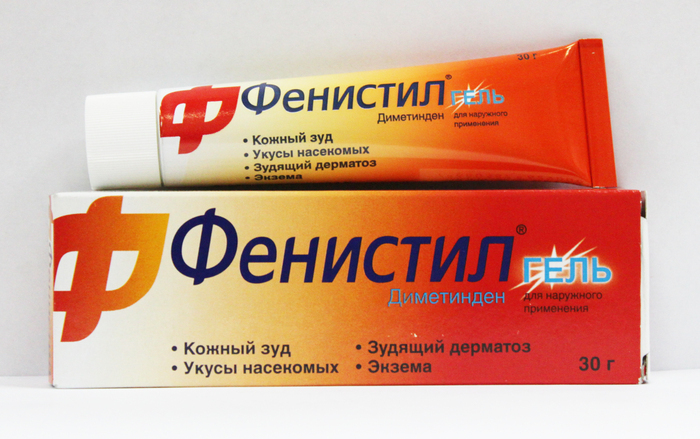
- Sinaflan - hormonal ointment has anti-edema and antibacterial properties, soothes irritations after insect bites. Apply to the affected areas 1 to 3 times a day, no more than 5 days. Use in infants is permissible under medical supervision. Price 50 - 90 rubles.
- Flucinar gel - hormonal potent drug, allowed from 2 years of age. Adults are recommended to apply the gel 2 times a day, children - 1 time, in a thin layer. The duration of use should not exceed 5 days. Not recommended for use on the face. Cost 200 - 400 rubles.
- Hydrocortisone1 % - hormonal ointment for severe itching and irritation, is used similarly to Flucinar. The cost is 20 - 60 rubles.
- Zinocap ointment - indicated for rashes, including dermatitis and neurodermatitis up to 3 times a day. Suitable for children over 1 year old. Cost 300 - 800 rubles.
- Balm Gold Star - used in liquid form, rubbing into the affected areas to relieve pain and irritation. It is recommended to apply immediately after the bite every 20 - 30 minutes. until the discomfort is completely eliminated. Price 100 - 200 rubles.
-
Psilo balm - gel to eliminate swelling and itching with a cooling effect. Applied up to 4 times a day, children are allowed from 2 years of age. Cost 250 - 350 rubles.
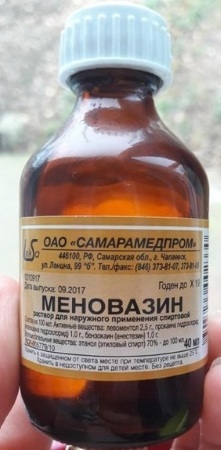
- Levomekol - gauze dressings with ointment are used for suppuration at the sites of insect bites until the purulent-necrotic contents are completely pulled out of the wound. Allowed for children from 1 year of age. Price 100 - 160 rubles.
- Miramistin - antiseptic and anti-inflammatory agent, applied to the bite site up to 4 times a day, regardless of the patient's age. Cost 250 - 800 rubles.
- Menovazine - alcohol solution to eliminate itching, has a soothing cooling effect and contains a small dose of anesthetic novocaine. It is applied up to 3 times a day, and the total duration of the course can be 3 - 4 weeks. Price 12 - 40 rubles.
In addition to the above drugs, you can disinfect the bite with the help of alcohol, chlorhexidine, iodine, brilliant green solution.
In order to prevent the occurrence of an allergic reaction from the bite or when signs of such appear, antihistamines should be taken immediately (Zodak, Suprastin, Zyrtec, Tsetrin, Loratadin, Tavegil). Children are advised to give them in advance, regardless of the existing symptoms.
Traditional methods
Alternative methods for flea bites are effective as first aid measures for minor rashes and the absence of allergic reactions. These are affordable means that are always at hand and can temporarily replace drugs that are not in the house.
First aid for bites is to disinfect and remove puffiness:
- wash the bite site with antibacterial or regular laundry soap;
- apply an antiseptic;
- apply a cold gauze compress or ice to the damaged area of the skin.
Next, you need to use pain relievers and anti-inflammatory drugs:
- Mix baking soda and water to a pasty consistency, apply the paste over the bite and allow to dry.
- For children, you can prepare a less concentrated alkaline solution with soda in a proportion of 1 tsp. l. soda in a glass of water. Apply a lotion to the affected areas.
Folk remedies with baking soda help neutralize the toxins contained in the insect's saliva and prevent the development of an allergic reaction, so they are most effective immediately after the bite.
- Foods that contain acid, such as lemon or vinegar, have disinfectant properties and can help prevent infection. To prepare the solution, mix 1 part of lemon juice (or apple cider vinegar) with 2 parts of water, apply a lotion on the affected skin.
- Aloe juice has soothing and regenerating properties. It is used in its pure form, lubricating bite wounds up to 3 times a day or applying a fresh leaf (having previously cut off the top layer of the skin on one side) as a compress.

- Black tea is known for similar properties. For bites, you can use regular tea bags, freshly brewed and cooled to a warm state. The lotions should be kept on the skin for at least 3 minutes.
- Compresses from decoctions of medicinal herbs (calendula, aloe, plantain, coltsfoot, string, chamomile) help to eliminate pain and relieve inflammation. For cooking, you need 2 tbsp. l. pour a glass of boiling water over any pharmacy plant and cook in a water bath for 10 - 15 minutes. Allow to cool slightly and apply warm (but not hot) lotions to the skin until the composition is completely cooled.
- Honey bites are used as an antimicrobial agent that neutralizes toxins. It is applied to the skin in its pure form and kept for up to 5 minutes.
Other methods
In case of an allergic reaction to a bite or an exacerbation of a chronic form of an allergic disease as a result of insect bites, the main methods therapies are supplemented with physiotherapy:
- electrophoresis or phonophoresis - the introduction of drugs using current or ultrasonic pulses;
- UV radiation and intravenous laser irradiation - used to change blood counts, relieve pain;
- darsonvalization - exposure to current pulses for an antiseptic effect and accelerate the healing process.
Patients suffering from chronic allergic diseases should periodically visit the salt rooms (speleotherapy) and carry out mud therapy procedures.
Also for any skin rash (including chickenpox, dermatoses, rubella) and to relieve itching children are prescribed a cosmetic preparation with natural ingredients - a lotion for external use Calamine. It is rubbed into the affected area from 3 to 7 times a day, according to the testimony of the doctor.
Possible complications
A flea bite on a person whose photo most often shows small red spots or blisters is rarely taken seriously.
However, such minor rashes can cause the development of serious pathologies and lead to:
- tachycardia;
- partial damage to the nervous system;
- prolonged heart pain and low blood pressure;
- suffocation attacks and panic attacks;
- swelling of the trachea, larynx;
- Quincke's edema;
- anaphylactic shock;
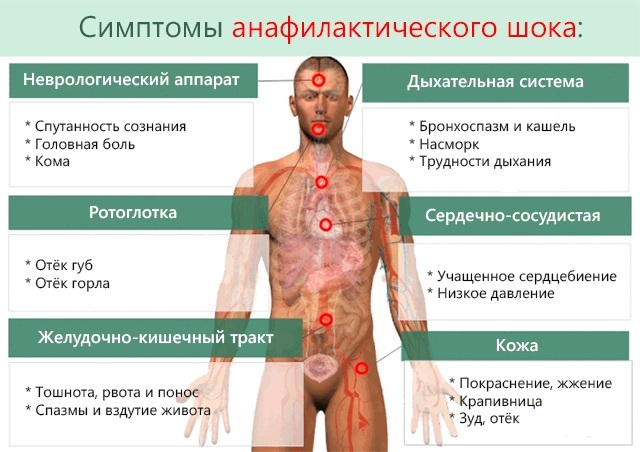
- lethal outcome.
In addition, parasite bites can change the psycho-emotional state - a person becomes nervous and irritable, it constantly itches, and in places of imaginary bites there are false pain sensations, not accompanied by typical bites redness. As a rule, this condition disappears when the parasites are completely eliminated.
Flea bites on a person are an unpleasant and rather painful phenomenon, not only in the aesthetic aspect (as evidenced by numerous photos consequences of flea attacks), but also from the point of view of medicine, since these insects are carriers of serious (and sometimes fatal) diseases for person.
Parasites can appear unexpectedly even in a perfectly clean apartment without pets, so you should not neglect preventive measures, and when cleaning, sometimes replace ordinary water with a solution of soap and soda.
Author: Anna Lalochkina
Flea Bite Video
Why are block bites dangerous and how to treat them:



